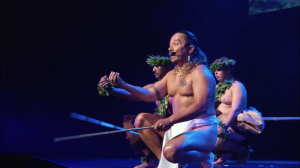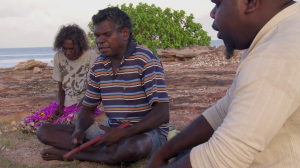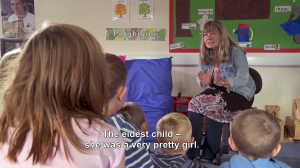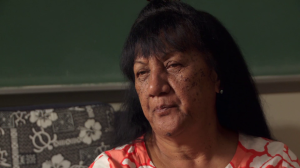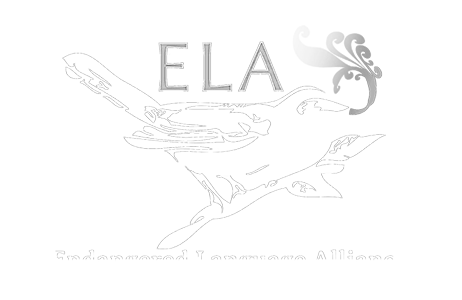The Crisis
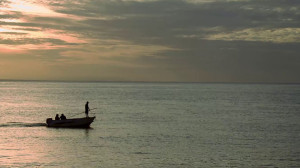 “Something like half the languages of the world are so seriously endangered that they’re going to die out in the course of the present century,” says linguist David Crystal in Language Matters. “That means one language dying out somewhere or other every two weeks on average.” Another recent estimate says that the last fluent native speaker of a language dies every three months.
“Something like half the languages of the world are so seriously endangered that they’re going to die out in the course of the present century,” says linguist David Crystal in Language Matters. “That means one language dying out somewhere or other every two weeks on average.” Another recent estimate says that the last fluent native speaker of a language dies every three months.
There are between 6,000 and 7,000 languages spoken in the world today. Languages have always come and gone, but what is happening today is “a global crisis of massive proportions,” says poet Bob Holman, host of Language Matters. Never before have so many languages disappeared so quickly, dying of unnatural causes. Some languages fall silent due to genocide; others because of language planning, migration education policy, and persecution; still others for economic or cultural reasons. As linguist and language activist Leanne Hinton puts it:
The decline of linguistic diversity in the world is linked to the world political economy which invades and takes over the territories of indigenous peoples, threatens the ecosystems in which they live, wipes out their traditional means of livelihood, and (at best) turns them into low-caste laborers in the larger society in which they must now live on the margins.
How do we know when a language is endangered? Every language can and has been used to express all aspects of society, says David Crystal; a first sign of endangerment is when a language starts to lose its functions, its use in certain contexts of daily life. Alongside this often come substantial changes to the actual structure of the language – not just some borrowed words, but deep changes to the sound and grammar of the language. Ultimately, the crucial question is whether a language is still being passed down to children. Two similar scales, one from the language database Ethnologue and the other from the United Nations, are used to measure a language’s degree of endangerment – but it’s the speakers in the community who usually know the real facts on the ground.
Most experts agree that approximately half of the world’s linguistic diversity is now endangered. These languages are usually unwritten, little documented, and spoken today by small or scattered communities with fewer than 10,000 people. Several hundred languages, now down to just a handful of speakers, are set to vanish much sooner. Among the Native American languages that have survived a long history of persecution, 90% are not being passed on to the next generation. In Australia, once home to over 300 indigenous languages spoken by half a million Aboriginal people, there are now fewer than 50 languages, almost all of them severely threatened.
Understand the endangered language crisis by the numbers, country by country.
Read more about what endangered languages are – and what’s being done to preserve them.
The Consequences
What is lost when a language disappears? A wealth of knowledge.The world’s languages have evolved as thousands of natural experiments, adaptations enabling speakers to survive and flourish in every imaginable historical and ecological context. Endangered languages are particularly rich in traditional knowledge about subsistence and survival strategies, medicinal herbs, local ecology, plants and animals unknown to Western science. Ecological, zoological, and botanical knowledge, embedded in languages, has been passed down for generations – and it’s often detailed and subtle, not easily extracted or translated.
In Language Matters, linguist Nick Evans describes one example of how the endangered Kunwinjku language of Australia encodes this kind of detailed knowledge through its semantics, connecting plants, animals, and the time. Kunwinjku uses the single word ngalyurr for a certain species of grasshopper (itself endangered), the herb species that grasshopper eats, and the onset of the wet season when that grasshopper appears. In English it is Leichhardt’s grasshopper, named after explorer Ludwig Leichhardt, who first discovered and wrote about this species in 1845. From the English name, we learn about the first white man to discover this grasshopper, 150 years ago. In Kunwinjku, the name gives us information about how the insect fits into the whole ecology of the place, information developed and used for tens of thousands of years. And ngalyurr is not an isolated case – there is a second grasshopper called man-yawok, and that same word is used to describe the end of the wet season and a particular species of yam which is best harvested at that time. To know these words is to have knowledge about the world.
The death of a language also means the disappearance of cultural creativity, the loss of traditions that often date back centuries or millennia. Language and culture are inseparable, as Hawaiian activist and hula master Keali’i Reichel explains in Language Matters:
We know that a language is how a particular culture and people interact with the world around them and with each other. And if you lose a language, then you lose a huge chunk of that culture…. We would lose everything. There is no culture without language. There is none. Because otherwise we would be speaking in a language that is not who we are and who we came from.
Every language represents a repository of the myths, stories, songs and rituals that give life meaning to a particular people. “Language is a force at the very center of culture,” says poet Bob Holman, “pulling all its many strands together.” Consider the songs of the Aboriginal song men, the poetry performances at the Welsh Eistedfodd, or the Hawaiian mele chants, all shown in Language Matters. Can translation into English, Chinese, or Arabic fill the gap if these are lost? Some sense can be transmitted, some basic information, but the poetry and the essence will be gone. Linguist Ken Hale once said that the loss of any single language “is like dropping a bomb on the Louvre.”An old Welsh proverb says, “A people without a language is a people without a heart.”
David Crystal, the author of over 100 books on language, identifies the lens on life, the unique and irreplaceable outlook on the world, which disappears when a language dies:
Each language is a vision of the world. Each language says something different about what it means to be human compared with any other language. And every language that is lost is a loss of a fragment of that vision.
Languages encode and embody the cultures that lives deep in the minds of its speakers. How we perceive space, color, time, family, friends – all this and much more is bound up to some degree in the languages we speak. As Nick Evans has written, different grammars condition “our ability to construct and participate in a shared mental world, to coordinate our attention and our goals, and to keep track of who knows, feels and wants what”— fundamental capacities for being alive.Subsuming cultural identity and traditional knowledge, there is a broader, less tangible “ecology of consciousness” that is lost along with a language.
Words, says Bob Holman, are central to lived experience:
Words are how we connect, and how we differ. Words are how we learn from and about each other, how we gossip, make poems, jokes and express our deepest wisdom – all in words.
“There is this strange relation between what exists and our expression of it,” adds another poet, W.S. Merwin, who also champions the Hawaiian language. Every human language gives access to an evolving universe of meaning, suggests Merwin – a space in which cultures, communities, and individuals are born and take root. For a speaker of any given language, that universe of meaning comes to constitutes a fundamental part of the self. For humanity as a whole, the collapse of universe after universe of meaning has even more drastic implications, cutting us off from who we are and have been as a species:
The meanings of course are there all the time. But one ceases to be able to touch them by losing the language. The language is what allows us to make the connection. And as language dies away in culture after culture, the connection with the meaning goes…. And when we lose it, we’re losing part of ourselves.
Read why some say languages are dormant, sleeping, or awakening, not dead or extinct.
The Response
On Goulburn Island, Aboriginal song man Solomon Nangamu single-handedly keeps a language alive – no one speaks Manangkardi anymore, but Solomon transmits wisdom and tradition to the next generation through his “song line.” In the rugged Welsh countryside, a determined movement of musicians, storytellers, and even freestyle rappers is breathing new life into ancient traditions, directly in the shadow of all-conquering English. In Hawai‘i, immersion schools are helping to reverse a language’s century-long decline.
Depicted in Language Matters, these stories illustrate some of the ways that communities are responding to the endangered language crisis. Whether a language will continue to be spoken or not ultimately depends on the speakers themselves. As Dafydd Iwan, the Welsh singer and language activist featured in Language Matters, puts it:
In the end, we have to remember that language is nothing without people. You know, a language is spoken by people, sung by people, laughed by people, cried by people, you know, and that’s what gives a language its life.
Most responses to endangerment begin with language documentation. If not recorded or written down, a lost language is gone forever, inaccessible to the community and to outsiders alike, with no traces preserved for future generations. The non-profit Endangered Language Alliance defines documentation as “the creation of high-quality digital recordings of stories, narratives, dialog or elicitation sessions on grammatical topics,” typically by linguists or trained community members; these are then transcribed, annotated, archived, and made widely available. In the last few decades, there has been a huge increase in activity, support, and funding by governments, non-profits, universities, and communities themselves. Also crucial is the work of filmmakers, writers, and artists, whose artistry can bring alive linguistic wonders for a broader community, as a recent upsurge in films, exhibits, poems, and musical performances attests.
Read more about the numerous organizations involved in language documentation.
Read an in-depth description of state-of-the-art language documentation.
Alongside documentation, communities are increasingly turning to a wide range of language revitalization strategies: developing literacy programs (beginning with designing a writing system), preparing educational materials or a dictionary, coining new words, holding classes or creating language nests, devising a Master-Apprentice Program, or making new media or art in the language.
Community attitudes are crucial. Linguistic privilege and prejudice reflect power relations in society and often operate unconsciously, until they become internalized by speakers of less common languages. Linguist David Crystal notes that the generation gap can be particularly large in fast-changing endangered language situations, necessitating an atmosphere of mutual respect. This basically translates to young people respecting the language of their elders, who in turn need to refrain from being too critical of youthful borrowings or “innovations.”
For some individuals and communities, even occasional usage – individual words, use in ritual contexts, music making, a radio program – can be a powerful identity marker. Others, like the Welsh and Hawaiian language activists profiled in Language Matters, launch wide-ranging movements aimed at the full-fledged restoration of a living spoken language. The revitalization of Hebrew as a living language in the early 20th century is a famous example, as is the revival of Basque and Catalan in Spain, and of Māori in New Zealand. Revitalization is extremely difficult when the language is already gone, and even a single new speaker can represent an extraordinary achievement. Native American and Aboriginal Australian languages, with smaller speaker numbers and little documentation, have faced the most serious challenges, but have also been a major area of recent activity. One well-known, ongoing example is the work of Jessie little doe Baird, who pioneered the Wôpanâak Language Reclamation Project in Massachusetts, reviving a language that had been dormant for over a century. Working first with old archival materials – often a necessity in revitalization work – Baird mastered the language herself and began teaching it to others, publishing materials, and leading classes, as chronicled in the documentary We Are Still Here by Anne Makepeace.
Read more about how different communities are maintaining their languages.
Read about Bringing Our Languages Home, an anthology of language revitalization stories from three continents.
Visit “Our Languages,” a resource for language revitalization activists, particularly in the Native American context.
Education, offline and online, is an increasingly important strategy for addressing language endangerment – as shown by the Hawaiian language activists in Language Matters, who have built an entire native-language education system from scratch, or the Welsh regional government, with its push for Welsh-medium education.
In the past, formal education systems have often been used against smaller languages. In Hawai‘i, children were forbidden to speak their mother tongue in school and forced to use English, though thousands could barely speak it. Native students in Australia and North America were sent against their will to notorious “boarding schools” where Native languages and cultures were systematically stamped through punishment and pressure – mouths washed out with soap and often worse. The Welsh Not, described in Language Matters, was a piece of string with a wooden placard tied to it, with the carved words “Welsh Not” (or the letters “WN”). Any student overheard speaking Welsh had to wear it, then it was passed to the next who was caught – whoever had it at the end of the day was beaten.
Today, communities are demanding restitution. Especially at the elementary school level, more communities are seeking either full mother-tongue education – every subject in the language, as at Nāwahī in Hawai‘i – or at least a strong second-language program.
Even if they have no formal credentials, native speakers like Lolena Nicholas, who have what Puakea Nogelmeier calls “a Ph.D. in living language,” are being recruited as invaluable teachers. Many tribes and communities now also have their own preschool immersion programs (like Pūnana Leo in Hawai‘i), summer schools, special workshops, and short-term immersion classes. In Wales, parents have a choice between sending their children to Welsh- or English-medium schools. Online education is also playing an ever-larger role, with language-learning websites, games, apps and dictionaries appearing for an increasing number of endangered languages.
See a list of some of the educational programs focused on Alaskan Native languages.
Public Policy is another way communities and individuals are responding to the endangered language crisis. In 2007 the United Nations adopted the Declaration on the Rights of Indigenous Peoples, which specifically mentions language rights, as does the Universal Declaration of Human Rights. Recognition as an official language can lead to everything from multilingual signage to use in government, court, and the education system – though official status has to be backed up with funding and follow-through. Hawaiian was recognized as an official state language in 1978. The Welsh Language Act of 1993, passed by the British Parliament, put Welsh and English on an equal footing in Wales. In 2003, Mexico passed its General Law on the Linguistic Rights of Indigenous Cultures, bolstering its support of the country’s 63 recognized indigenous languages. In 2014, the Alaska legislature passed a bill making the state’s 20 Native languages official alongside English – and similar movements are growing elsewhere. All governments have an official or unofficial language policy. What language activists can do is ensure that the issue of endangered languages is understood as a matter of human rights and minority rights.
Learn more about the law making Alaska’s native languages official.
Read a paper on the impact that language policy can have on endangered languages.
